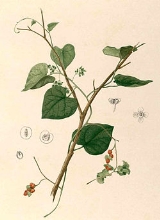
Cissampelos
Encyclopedia
Cissampelos is a genus of flowering plants in the family Menispermaceae
.
Cissampelos pareira
is used in Chinese herbology
, where it is called xí shēng téng (锡生藤) or (亞乎奴). The species is also known as abuta and is also called laghu patha in Ayurvedic medicine
. An ethanol extract of Cissampelos sympodialis has been shown to have antidepressant-like effects in mice and rats.
The Maasai people of Kenya
use Cissampelos mucronata as a forage
for their cattle.
Menispermaceae
Menispermaceae, the botanical name for a family of flowering plants, has been universally recognized by taxonomists. Tubocurare, a neuromuscular blocker and active ingredient in curare, is derived from plants of this family....
.
Cissampelos pareira
Cissampelos pareira
Cissampelos pareira is a species of flowering plant in the family Menispermaceae.-Medicinal uses:Cissampelos pareira is used in Chinese herbology, where it is called xí shēng téng or . The species is also known as abuta and is also called laghu patha in Ayurvedic medicine...
is used in Chinese herbology
Chinese herbology
Chinese Herbology is the theory of Traditional Chinese herbal therapy, which accounts for the majority of treatments in Traditional Chinese medicine ....
, where it is called xí shēng téng (锡生藤) or (亞乎奴). The species is also known as abuta and is also called laghu patha in Ayurvedic medicine
Ayurveda
Ayurveda or ayurvedic medicine is a system of traditional medicine native to India and a form of alternative medicine. In Sanskrit, words , meaning "longevity", and , meaning "knowledge" or "science". The earliest literature on Indian medical practice appeared during the Vedic period in India,...
. An ethanol extract of Cissampelos sympodialis has been shown to have antidepressant-like effects in mice and rats.
The Maasai people of Kenya
Kenya
Kenya , officially known as the Republic of Kenya, is a country in East Africa that lies on the equator, with the Indian Ocean to its south-east...
use Cissampelos mucronata as a forage
Forage
Forage is plant material eaten by grazing livestock.Historically the term forage has meant only plants eaten by the animals directly as pasture, crop residue, or immature cereal crops, but it is also used more loosely to include similar plants cut for fodder and carried to the animals, especially...
for their cattle.

